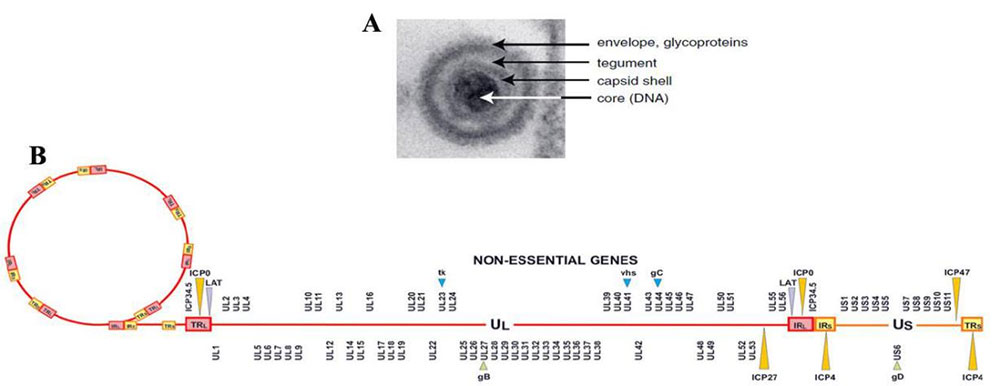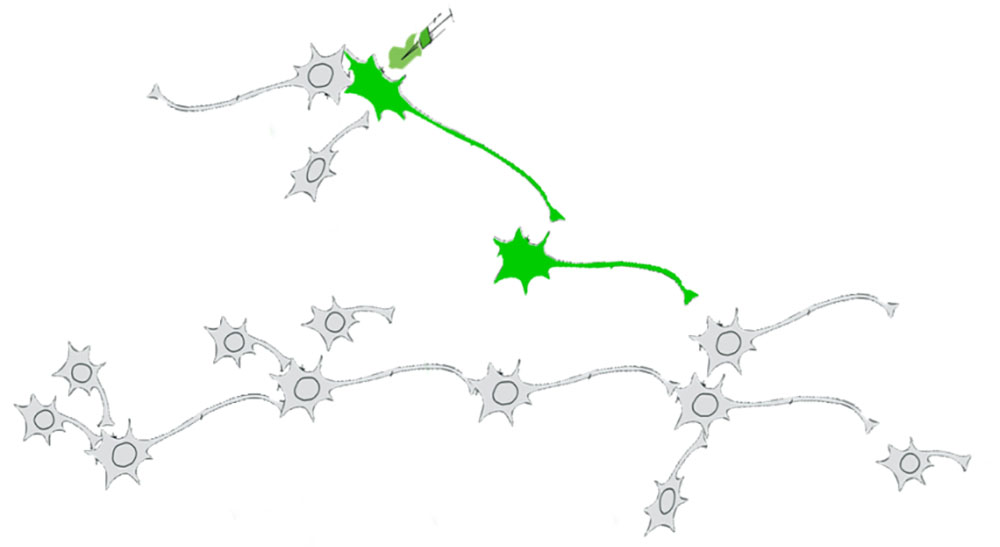- E-mail:BD@ebraincase.com
- Tel:+8618971215294
Herpes simplex virus (HSV) belongs to the family Herpesviridae and subfamily Alphaherpesvirinae, and has two subtypes, HSV-1 and HSV-2. The HSV genome is a linear double-stranded DNA of about 152 kb, composed of covalently linked long fragments (UL) and short fragments (US), each fragment containing a single sequence and an inverted repeat sequence. After the virus infects the host cell, the genome undergoes cyclization. Nearly half of the HSV genome is non-essential genes, and there is a large space for genetic modification. Large fragments of foreign genes or multiple transgenes can be simultaneously introduced into the viral genome. (Figure 1)

Figure 1 Electron micrograph and genome composition of HSV virions
H129 is a clinical isolate of HSV-1 virus with specific orthodromic transsynaptic properties. After years of in vivo tests in various animal models, it was found that it can not only mark the connection between different brain regions of the central nervous system, but also mark the connection between different peripheral and central brain regions. After the modified virus is loaded with fluorescent protein, it can achieve efficient and stable antegrade transsynaptic labeling of neuron networks, which is suitable for antegrade tracing research on neural output circuits. HSV infects a wide range of hosts, and is of great value in the study of the downstream output loop of neural information in mice, non-human primates, and other mammalian and avian experimental animals.
According to different experimental purposes, it can be divided into three categories: HSV amplicon, HSV anterograde mutisynaptic tracing system and anterograde monosynaptic tracing system.
The HSV-1 amplicon vector is a pseudovirus vector that does not contain viral structural proteins, but only contains the replication origin ori of HSV-1, the cutting and packaging signal pac, and the foreign gene expression cassette. Has the following characteristics:
These advantages make the HSV-1 amplicon carrier a very powerful vector for gene therapy of nervous system diseases, and open up the way for gene therapy of various systemic diseases such as the central nervous system.
HSV-1 strain H129 has specific anterograde transsynaptic properties. After the virus infects nerve cells, it replicates and expresses the target gene in the cell, and the progeny virus is transported to the pre-synapse through the axon, enters the downstream neurons across the synapse, and begins a new round of replication and trans-synaptic transmission. After the fluorescent gene is inserted into its genome, it can achieve the effect of labeling neurons across multilevel synapses in forward direction.
Herpes simplex virus thymidine kinase (HSV-TK) plays an important role in acute ganglion replication and recurrent latent ganglion infection after HSV infection of neurons (Coen et al., PNAS, 1989). When HSV-TK is missing, HSV-ΔTK can infect neurons, but cannot replicate, thus losing the ability to cross synapses. In the presence of a TK-expressing helper virus, HSV-ΔTK-hUbC-tdTomato can propagate from initiating neurons to postsynaptic neurons, thereby marking the immediate descendants of a given brain region or specific type of neuron innervated neurons. The anterograde mono-transsynaptic labeling system greatly facilitates the study of direct output neural networks.
In 2020, Professor Xu Fuqiang's research team at the Shenzhen Institute of Advanced Technology, Chinese Academy of Sciences, reported a rigorous and practical monosynaptic anterograde tracing recombinant virus Hs06 system. They embedded the anti-Her2 scFv (single-chain antibody variable) region into the gDΔ6–38 region of the H129 envelope glycoprotein D (gD) to infect neurons that only express the Her2 receptor. This achieved specificity in targeting the initial site of H129 to Her2-expressing cells, thereby eliminating the reuptake ability of the original H129 strain at axon terminals.(Hs06 system)

Figure 2. Schematic diagram of forward labeling of neurons across a single stage
The use of HSV amplicon viral vectors can achieve overexpression of large fragment vector genes (> 5Kb).
| Virus name | Virus color and application |
| H129-hUbC-EGFP-WPRE | Polysynaptic anterograde tracing , Green |
| H129-hUbC-tdTomato-WPRE | Polysynaptic anterograde tracing , Green |
| H129-hUbC-HBEGFP-WPRE | Highlight version, Green, Polysynaptic anterograde tracing, |
| H129△TK-hUbC-tdTomato-WPRE | Monosynaptic anterograde tracing , Red |
| H129△TK-CAG-LSL-tdTomato-WPRE | Cre dependence, Monosynaptic anterograde tracing , Red |
| H129△TK-CAG-LSL-tdT-2A-YK-WPRE | Cre dependence, Polysynaptic anterograde tracing, Red |
| H129△TK-LSL-tdT/△R-EGFP | Retrograde, composition in Green, Cre dependence in Red |